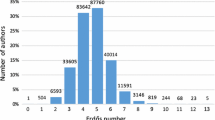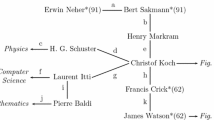Abstract
It is widely recognized that conceptual and theoretical innovations and the employment of new instruments and experimental techniques are important factors in explaining the growth of scientific knowledge in chemistry. This study examines another dimension of research in chemistry, collaboration and co-authorship. I focus specifically on Theodore Richards’ career and publications. During the period in which Richards worked, co-authorship was beginning to become more common than it had been previously. Richards was the first American chemist to be awarded a Nobel Prize and he was at the forefront in this new trend in chemistry. He collaborated more than was typical for his time, with many scientists, in different sized groups, and he often had persistent collaborative relationships, extending over a number of years. Further, it appears that these collaborations benefited Richards, his collaborators, and the field of chemistry as a whole.






Similar content being viewed by others
Notes
The Nobel Prize was just one of many honors bestowed on Richards between 1901 and 1914. He also received: “a call to Göttingen, a princely new laboratory, medals from the Royal Society, the Chemical Society of London, and the American Chemical Society, honorary degrees from Oxford and Cambridge” (Servos 1990, 79). He was also appointed to the editorial board of Zeitschrift für physikalische Chemie (see Servos 1990, 56).
In the journal Science, in 2010, only about 1% of the published papers were single-author publications (see Wray and Andersen 2018, 2015).
For example, Richards reports in 1898 that a particular paper “will appear in the September numbers of Zeitschrift für physikalische Chemie and the American Journal of Science” (Richards 1898, 726).
I thank Alex Csiszar for information on these turn-of-the-century publication practices.
Two of Richards’ collaborators were ultimately also relatives by marriage: Lawrence Henderson married Edith Thayer, Richards’ wife’s sister (see Conant 2017, 81); and James B. Conant married Grace Richards, Theodore Richards’ daughter.
I question whether Kopperl is correct in counting Allan Rowe as a student or former student of Richards. I discuss Rowe’s education below. Formally, he was not a student of Richards. A referee for FOC inquired whether Richards collaborated with all his graduate students. I am not in a position to answer this question, as I do not have a complete list of Richards’ students. The referee also inquired about the nationality of Richards’ co-authors. Again, I am not in a position to provide a systematic analysis, but Richards’ co-authors included chemists from Canada, Czechoslovakia, Germany, and Japan.
If we remove the one outlier of 22 years, then the mean of the remaining 29 is 3.03 years.
The practice of counting fractions of papers is commonplace in scientometrics.
In fact, earlier, in the three-year period of 1894–1896, Richards’ collaborative output outstripped his output of single-authored papers. But this did not become a settled pattern until later.
In fact, Richards was awarded the Nobel Prize in 1915. “During the selection process in 1914, the Nobel Committee for Chemistry decided that none of the year’s nominations met the criteria as outlined in the will of Alfred Nobel. According to the Nobel Foundation’s statutes, the Nobel Prize can in such a case be reserved until the following year, and this statute was then applied. Theodore W. Richards therefore received his Nobel Prize for 1914 one year later, in 1915” (see Presentation 2022).
Shipley was awarded his Ph.D. in 1913 (see Goldsborough 2014).
Servos claims that “Richards’ work on the theory of compressible atoms proved a cul-de-sac. Sympathetic biographers have noted that it led him to anticipate certain later developments in atomic theory, but such anticipations appeared amidst a mélange of speculative musings that exercised little influence on those who were actually responsible for reshaping atomic theory in the early twentieth century—Thomson, Rutherford, Bohr” (Servos 1990, 80).
With support from Harvard, Richards “traveled to Germany to study physical chemistry” (Servos 1990, 79). As John Servos explains, “Harvard … was interested in grooming Richards to take over the courses taught by the lately deceased Josiah Parsons Cooke, Richards’ mentor. Richards returned to Harvard with new interests in thermochemistry and electrochemistry” (Servos 1990, 79).
Harold Hartley (1930) provides a thorough account of Richards’ legacy with respect to the determinations of atomic weights. According to Hartley, “Richards investigated either with his own hands or with the aid of his pupils the atomic weights of twenty-five elements … If we add to these the atomic weights determined independently by Baxter and those by Hönigschmid using the Harvard technique, we find that, of the 92 elements, our knowledge of the atomic weights of no less than 55 rests to a large extent on the work of Richards and his former students” (Hartley 1930, 1959). Hartley provides a full list of these elements on page 1950 in a chart and in notes (see Hartley 1930, 1950).
The paper Baxter published with Burgess also included H. D. Daudt as a co-author. And the paper published with Honigschmid included M. M. Curie, P. Lebeau, and R. J. Meyer as co-authors.
The issue discussed in this section was suggested to me by a referee for the journal.
References
Berry, S.: Gregory P. Baxter, 1876–1953. Biographical memoirs. National Academy of Sciences (2018). http://www.nasonline.org/publications/biographical-memoirs/memoir-pdfs/baxter-gregory.pdf
Cohen, J.E.: Publication rate as a function of laboratory size in three biomedical research institutions. Scientometrics 3(6), 467–487 (1981)
Conant, J.: Man of the Hour: James B. Conant, Warrior Scientist. Simon & Schuster Paperbacks, New York (2017)
Conant, J.B.: Theodore William Richards. In: Biographical Memoir, pp. 251–286. National Academy of Science, Washington (1974)
Harvard Crimson: Gibbs Laboratory Ready: New Building for Physical-Chemical Research, Most Complete of its Kind, Nearly Finished. Harvard Crimson (December 20, 1912) (1912). https://www.thecrimson.com/article/1912/12/20/gibbs-laboratory-ready-pthe-wolcott-gibbs/. Accessed 25 Feb 2022
Cronin, B., Shaw, D., La Barre, K.: Visible, less visible, and invisible work: patterns of collaboration in 20th century chemistry. J. Am. Soc. Inform. Sci. Technol. 55(2), 160–168 (2004)
Csiszar, A.: How lives became lists and scientific papers became data: cataloguing authorship during the nineteenth century. Br. J. Hist. Sci. 50(1), 23–60 (2017)
de Price, D.S.: Little Science, Big Science. Columbia University Press, New York (1963)
Forbes, G.S.: Investigations of atomic weights by Theodore William Richards. J. Chem. Educ. 9(3), 452–458 (1932)
Goldsborough, G.: Memorable MANITOBANS: John Wesley Shipley (1878–1943). Manitoba Historical Society (2014). http://www.mhs.mb.ca/docs/people/shipley_jw.shtml. Accessed 25 Feb 2022
Hartley, H.: Theodore William Richards memorial lecture. J. Chem. Soc. 25, 1937–1969 (1930)
Kopperl, S.J.: T. W. Richards’ role in American graduate education in chemistry. Ambix 23(3), 165–174 (1976)
Norris, J.F.: Allan Winter Rowe (1879–1934). Proc. Am. Acad. Arts Sci. 72(10), 385–387 (1938)
Presentation: NobelPrize.org. Nobel Prize Outreach AB 2022. Mon. 17 Jan 2022 (2022). https://www.nobelprize.org/prizes/chemistry/1914/press-release/
Richards, T.W.: Progress in physical chemistry. Science VIII(204), 721–727 (1898)
Richards, T.W.: Recent research in the Wolcott Gibbs Memorial Laboratory of Harvard University. Science 42(1094), 845–851 (1915)
Servos, J.W.: Physical Chemistry from Ostwald to Pauling: The Making of Science in America. Princeton University Press, Princeton (1990)
Simonton, D.K.: Creativity in Science: Chance, Logic, Genius, and Zeitgeist. Cambridge University Press, Cambridge (2004)
Wray, K.B., Andersen, L.E.: Retractions in science. Scientometrics 117, 2009–2019 (2018)
Zuckerman, H., Merton, R.K.: Age, aging, and age structure in science. In: Merton, R.K. (ed.) The Sociology of Science: Theoretical and Empirical Investigations, Edited and with an Introduction by N. W. Storer, pp. 467–559. University of Chicago Press, Chicago (1972/1973)
Zuckerman, H.: Scientific Elite: Nobel Laureates in the United States. Transaction Publishers, New Brunswick (1977/1996)
Acknowledgements
I thank Lori Nash and Jeff Seeman for critical feedback on an earlier draft. I also thank my audience at the International Conference on the History of Chemistry, in Vilnius, Lithuania, in May 2023. Finally, I thank the referee for Foundations in Chemistry for their encouraging and insightful referee’s report. I dedicate this paper to the memory of Søren Rud Keiding (1959-2023), the former director of AIAS.
Funding
This research was not supported by a grant.
Author information
Authors and Affiliations
Corresponding author
Ethics declarations
Conflict of interest
There are no conflicts of interest.
Additional information
Publisher's Note
Springer Nature remains neutral with regard to jurisdictional claims in published maps and institutional affiliations.
Rights and permissions
Springer Nature or its licensor (e.g. a society or other partner) holds exclusive rights to this article under a publishing agreement with the author(s) or other rightsholder(s); author self-archiving of the accepted manuscript version of this article is solely governed by the terms of such publishing agreement and applicable law.
About this article
Cite this article
Wray, K.B. Co-authorship in chemistry at the turn of the twentieth century: the case of Theodore W. Richards. Found Chem (2023). https://doi.org/10.1007/s10698-023-09491-w
Accepted:
Published:
DOI: https://doi.org/10.1007/s10698-023-09491-w




